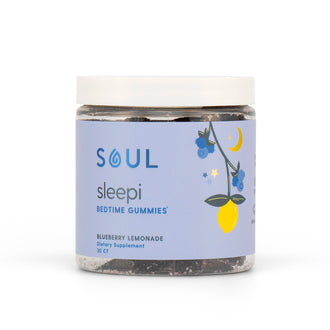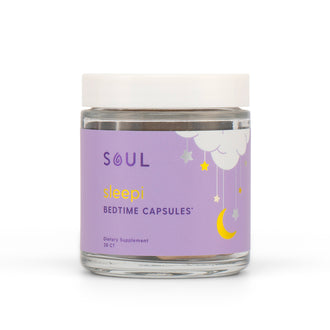
Key Takeaways:
- Recognize Signs: Understand the common causes and effects of anxiety in dogs and how to recognize the signs.
- Practical Strategies: Implement practical strategies such as creating a safe environment, using calming products, and maintaining a consistent routine.
- Diet and Socialization: Explore the role of diet, socialization, and professional help in managing and reducing your dog's anxiety.
At Soul, we pride ourselves on delivering wellness products that are both delicious and efficacious, backed by science and crafted with care. Our commitment to quality and innovation has earned us the trust of countless customers seeking natural solutions for their health and wellness needs.
Dog anxiety is a common issue that can significantly impact your pet's quality of life. Understanding the causes and effects of anxiety in dogs, along with effective strategies for managing it, is crucial for pet owners. In this comprehensive guide, we will explore various aspects of dog anxiety, from its symptoms and causes to practical solutions that can help your furry friend feel more relaxed and secure.
In this piece, we will be discussing effective strategies to calm your anxious dog, including dietary considerations, the importance of routine, and professional help options.
Understanding Dog Anxiety
Dog anxiety is a common issue that can affect dogs of all ages and breeds. It manifests as a feeling of unease, fear, or panic in response to specific triggers or situations. Just like humans, dogs can experience anxiety for various reasons, and it can significantly impact their quality of life. Understanding the nature of anxiety in dogs is the first step in effectively managing and alleviating it.
Anxiety in dogs can be categorized into three main types:
- Separation Anxiety: This occurs when a dog becomes distressed in the absence of their owner or primary caregiver. It's the most common type of anxiety in dogs and can lead to destructive behaviors, excessive barking, and attempts to escape.
- Environmental Anxiety: This type of anxiety is triggered by changes in a dog's environment. It could be due to moving to a new home, loud noises such as thunderstorms or fireworks, or unfamiliar visitors.
- Social Anxiety: Some dogs may feel anxious around other animals or people, especially if they have not been properly socialized. This can result in fear-based aggression, hiding, or excessive submissive behaviors.
Recognizing and understanding these types of anxiety is crucial for providing the appropriate support and interventions for your dog.
Common Causes Of Anxiety In Dogs
Understanding the root causes of anxiety in dogs is essential for addressing the issue effectively. Various factors can contribute to anxiety, and identifying these can help in developing a tailored approach to calm your anxious dog. Here are some common causes:
Genetics
Certain breeds are more predisposed to anxiety due to their genetic makeup. For instance, small breeds like Chihuahuas and larger breeds like German Shepherds often exhibit higher levels of anxiety.
Past Trauma
Dogs that have experienced traumatic events, such as abuse, neglect, or a serious accident, are more likely to develop anxiety. Rescue dogs, in particular, may exhibit anxiety due to their past experiences.
Lack Of Socialization
Puppies that are not adequately socialized during their critical developmental periods may grow up to be anxious adults. Early exposure to various people, animals, environments, and experiences is crucial.
Changes In Environment
Significant changes such as moving to a new home, the arrival of a new family member, or even rearranging furniture can cause anxiety in dogs. They thrive on routine and familiarity.
Medical Issues
Sometimes, underlying health problems can cause or exacerbate anxiety in dogs. Pain, hormonal imbalances, or neurological conditions may contribute to increased anxiety levels.
Owner Behavior
Dogs are highly perceptive and can pick up on their owner's stress and anxiety. Anxious owners can unintentionally transfer their stress to their pets, exacerbating the dog's anxiety.
How Anxiety Affects Dogs
Anxiety can have a profound impact on a dog's overall well-being, affecting them both physically and emotionally. Understanding these effects can help you recognize the seriousness of the issue and take appropriate steps to address it. Here are some ways anxiety affects dogs:
Behavioral Changes
An anxious dog may exhibit various behavioral changes, such as excessive barking, whining, or howling. They might become destructive, chewing on furniture, shoes, or other items around the house. Some dogs may also become aggressive or overly submissive when anxious, displaying increased fearfulness or defensiveness in various situations.
Physical Symptoms
Anxiety can manifest in physical symptoms, including trembling, panting, pacing, and excessive drooling. Some dogs may also experience digestive issues, such as diarrhea or vomiting, when they are anxious. These physical symptoms can be distressing for both the dog and the owner, making it clear that the dog is suffering.
Health Problems
Chronic anxiety can lead to more severe health problems over time. It can weaken the immune system, making dogs more susceptible to illnesses. Additionally, constant stress can exacerbate existing medical conditions or lead to new ones, such as skin conditions, heart problems, or chronic gastrointestinal issues.
Sleep Disturbances
An anxious dog may have trouble sleeping or may sleep excessively as a way to cope with their anxiety. Disrupted sleep patterns can further contribute to their stress and overall health. Lack of restful sleep can also lead to increased irritability and a weakened immune response.
Avoidance Behavior
Dogs with anxiety may start to avoid certain situations, people, or places that trigger their anxiety. This can limit their ability to enjoy normal activities and can affect their socialization, leading to further isolation and fear. Avoidance behavior can also interfere with training and daily routines, making it harder for the dog to adapt to new experiences.
Loss Of Appetite
Anxiety can cause changes in a dog's eating habits. Some dogs may lose their appetite and refuse to eat, leading to weight loss and nutritional deficiencies. Conversely, others may overeat as a way to cope with stress, which can lead to obesity and related health issues.
Recognizing The Signs Of Anxiety In Your Dog
Recognizing the signs of anxiety in your dog is the first step towards helping them. Dogs communicate their feelings through their behavior and body language, so it's important to be observant and attentive. Here are some common signs that your dog may be experiencing anxiety:
- Restlessness: An anxious dog may have difficulty settling down. They might pace back and forth, circle, or exhibit other restless behaviors.
- Excessive Barking or Whining: Dogs often vocalize their anxiety through excessive barking, whining, or howling, especially when left alone or exposed to stressors.
- Destructive Behavior: Anxiety can lead to destructive behaviors such as chewing on furniture, digging at carpets, or scratching doors. This is often a way for dogs to release pent-up stress.
- Panting and Drooling: Increased panting and drooling, even when the dog is not hot or thirsty, can be a sign of anxiety.
- Shaking or Trembling: Some dogs physically shake or tremble when they are anxious. This is more noticeable in certain breeds but can occur in any dog.
- Hiding or Avoidance: An anxious dog may try to hide or avoid certain situations or people. They might seek out small, enclosed spaces where they feel safer.
- Changes in Body Posture: Watch for changes in your dog's body posture, such as a lowered head, flattened ears, tucked tail, or a hunched back. These can all be signs of fear and anxiety.
- Loss of Appetite: A noticeable decrease in appetite or refusal to eat can indicate anxiety. Conversely, some dogs might eat excessively due to stress.
- Aggression: In some cases, anxiety can lead to aggressive behaviors. This might include growling, snapping, or biting, particularly if the dog feels cornered or threatened.
- Excessive Licking or Grooming: Dogs may engage in excessive licking or grooming of themselves, which can lead to bald spots or skin infections.
By paying attention to these signs, you can identify when your dog is feeling anxious and take steps to address the underlying causes and provide comfort.
Effective Strategies To Calm Your Anxious Dog
Calming an anxious dog requires a combination of strategies tailored to their specific needs and triggers. Here are some effective methods to help reduce your dog's anxiety:
Creating a Safe Environment
- Designated Safe Space: Create a comfortable and quiet area where your dog can retreat when they feel anxious. This space should have their bed, favorite toys, and maybe an item of your clothing to provide comfort.
- Consistent Routine: Dogs thrive on routine. Establish a consistent daily schedule for feeding, walking, and playtime to provide a sense of security and predictability.
- Reduce Noise: If your dog is sensitive to loud noises, consider using white noise machines or playing calming music to help mask the sounds that trigger their anxiety.
Physical Exercise and Mental Stimulation
- Regular Exercise: Ensure your dog gets plenty of physical exercise to burn off excess energy and reduce anxiety. Long walks, runs, or play sessions can be very beneficial.
- Mental Stimulation: Engage your dog in activities that challenge their mind, such as puzzle toys, training sessions, or interactive games. Mental stimulation can help distract them from anxiety-inducing stimuli.
Calming Products and Supplements
- Calming Treats and Supplements: There are various treats and supplements formulated with ingredients like CBD, chamomile, or valerian root that can help calm your dog's nerves.
- Thundershirts and Anxiety Wraps: These products apply gentle pressure to your dog's body, similar to swaddling a baby, which can have a calming effect.
- Aromatherapy: Certain scents, such as lavender, can have a calming effect on dogs. Use pet-safe essential oils for calming sprays in their environment.
Training and Behavior Modification
- Desensitization: Gradually expose your dog to the things that trigger their anxiety in a controlled and positive manner to help them become less reactive over time.
- Counter-Conditioning: Teach your dog to associate anxiety-inducing situations with positive experiences. For example, give treats or play with them when they encounter a trigger.
- Obedience Training: Reinforce basic commands and practice them regularly. A well-trained dog feels more secure and is easier to manage in stressful situations.
Professional Help and Therapy
- Veterinarian Consultation: If your dog's anxiety is severe, consult with your veterinarian. They may recommend medication or other treatments to help manage your dog's anxiety.
- Professional Dog Trainer or Behaviorist: Seek help from a certified dog trainer or behaviorist who specializes in anxiety issues. They can provide personalized strategies and support.
- Animal-Assisted Therapy: In some cases, professional therapy programs involving trained therapy animals can be beneficial in reducing anxiety in dogs.
Implementing these strategies can significantly help in calming your anxious dog and improving their overall well-being.
The Role Of Diet In Managing Dog Anxiety
Diet plays a crucial role in your dog's overall health and can significantly impact their anxiety levels. Providing the right nutrition can help manage and even reduce anxiety in your dog. Here are some dietary considerations to keep in mind:
- High-Quality Proteins: Ensure your dog’s diet includes high-quality proteins, which are essential for brain function and overall health. Proteins provide amino acids, such as tryptophan, which can have a calming effect.
- Omega-3 Fatty Acids: Foods rich in omega-3 fatty acids, like fish oil, can help reduce inflammation and support brain health. Omega-3s have been shown to have calming properties that can help manage anxiety.
- Complex Carbohydrates: Including complex carbohydrates, such as brown rice, sweet potatoes, and oats, can help stabilize your dog's blood sugar levels and provide a steady source of energy. This can prevent anxiety-related energy spikes and crashes.
- Antioxidants: Incorporate antioxidant-rich foods like blueberries, spinach, and carrots into your dog's diet. Antioxidants support overall brain health and can help mitigate the effects of stress.
- Vitamins and Minerals: Ensure your dog gets a balanced intake of vitamins and minerals, particularly B vitamins, magnesium, and zinc, which are known to support nervous system health and reduce anxiety.
- Probiotics: Gut health is linked to overall well-being, including mental health. Probiotics can help maintain a healthy gut microbiome, which can positively impact your dog's anxiety levels.
- Avoiding Artificial Additives: Steer clear of dog foods that contain artificial colors, flavors, and preservatives, as these can negatively affect your dog's health and potentially increase anxiety.
- Calming Supplements: Consider adding supplements specifically designed to reduce anxiety. These might include ingredients like L-theanine, chamomile, valerian root, or CBD, which have calming properties.
Consulting with your veterinarian before making significant changes to your dog's diet is essential to ensure their specific needs are met. By providing a nutritious and balanced diet, you can help support your dog's overall health and reduce anxiety.
Final Thoughts
Helping your dog overcome anxiety is a journey that requires patience, understanding, and consistency. By recognizing the signs of anxiety and understanding its causes, you can implement effective strategies to create a calm and secure environment for your furry friend. Consistently applying these strategies and maintaining a routine will gradually help reduce your dog's anxiety. It’s important to show empathy and understanding towards your dog’s fears, as this strengthens your bond and provides the reassurance they need. Monitoring your dog's behavior and progress is crucial, making adjustments based on what strategies work best. If your dog’s anxiety is severe or persistent, don't hesitate to seek professional help from veterinarians or behaviorists who can offer specialized guidance and support.
Read also:
- Effective and Safe Natural Sleep Remedies: Your Ticket to a Restful Night
- Choosing the Right Appetite Suppressant
- Exploring THCB: Benefits and Uses
Frequently Asked Questions About Strategies To Calm Your Anxious Dog
What are some natural remedies for calming an anxious dog?
Natural remedies include chamomile, valerian root, CBD oil, and lavender. These can be administered through treats, oils, or diffusers and have calming effects on dogs.
Can music help calm an anxious dog?
Yes, playing calming music or white noise can help soothe an anxious dog. Classical music or specially designed dog music playlists can create a relaxing environment.
How does physical touch affect an anxious dog?
Physical touch, such as gentle petting or massaging, can release oxytocin and endorphins in your dog, helping to reduce stress and anxiety.
Are there specific toys that help with dog anxiety?
Interactive toys, such as puzzle feeders and chew toys, can provide mental stimulation and distraction, which can help alleviate anxiety in dogs.
Can anxiety in dogs be seasonal?
Yes, some dogs may experience increased anxiety during specific seasons due to changes in weather, increased noise from thunderstorms or fireworks, or alterations in routine.
What role do pheromones play in calming dogs?
Pheromone diffusers release synthetic versions of calming pheromones that dogs naturally produce, helping to create a sense of security and reduce anxiety.
How can I help my dog with travel anxiety?
Gradual desensitization to car rides, providing a comfortable travel crate, and using calming products like pheromone sprays can help reduce travel anxiety in dogs.
Is it possible for a dog to outgrow anxiety?
While some dogs may outgrow certain anxieties, others might need ongoing management. Consistent training, socialization, and creating a secure environment can help reduce anxiety over time.
How do diet changes affect dog anxiety?
A balanced diet rich in omega-3 fatty acids, antioxidants, and high-quality proteins can support overall brain health and reduce anxiety. Consult with a veterinarian for tailored dietary advice.
What signs indicate that my dog’s anxiety might require professional intervention?
Severe signs such as persistent destructive behavior, aggression, self-harm (excessive licking or biting), or significant changes in appetite and sleep patterns may require professional intervention from a veterinarian or behaviorist.
Sources:
- Landa, L., Trojan, V., Demlova, R., Jurica, J., & Hrib, R. (2022). Cannabidiol and the possibilities of its use in veterinary medicine of dogs and horses: A brief review. Veterinární Medicína, 67(No. 9), 455–462. https://doi.org/10.17221/127/2021-vetmed
- Hunt, A. B. G., Flint, H. E., Logan, D. W., & King, T. (2023). A single dose of cannabidiol (CBD) positively influences measures of stress in dogs during separation and car travel. Frontiers in Veterinary Science, 10. https://doi.org/10.3389/fvets.2023.1112604
- Bradley, S., Young, S., Bakke, A. M., Holcombe, L., Waller, D., Hunt, A., Pinfold, K., Watson, P., & Logan, D. W. (2022). Long-term daily feeding of cannabidiol is well-tolerated by healthy dogs. Frontiers in Veterinary Science, 9. https://doi.org/10.3389/fvets.2022.977457






